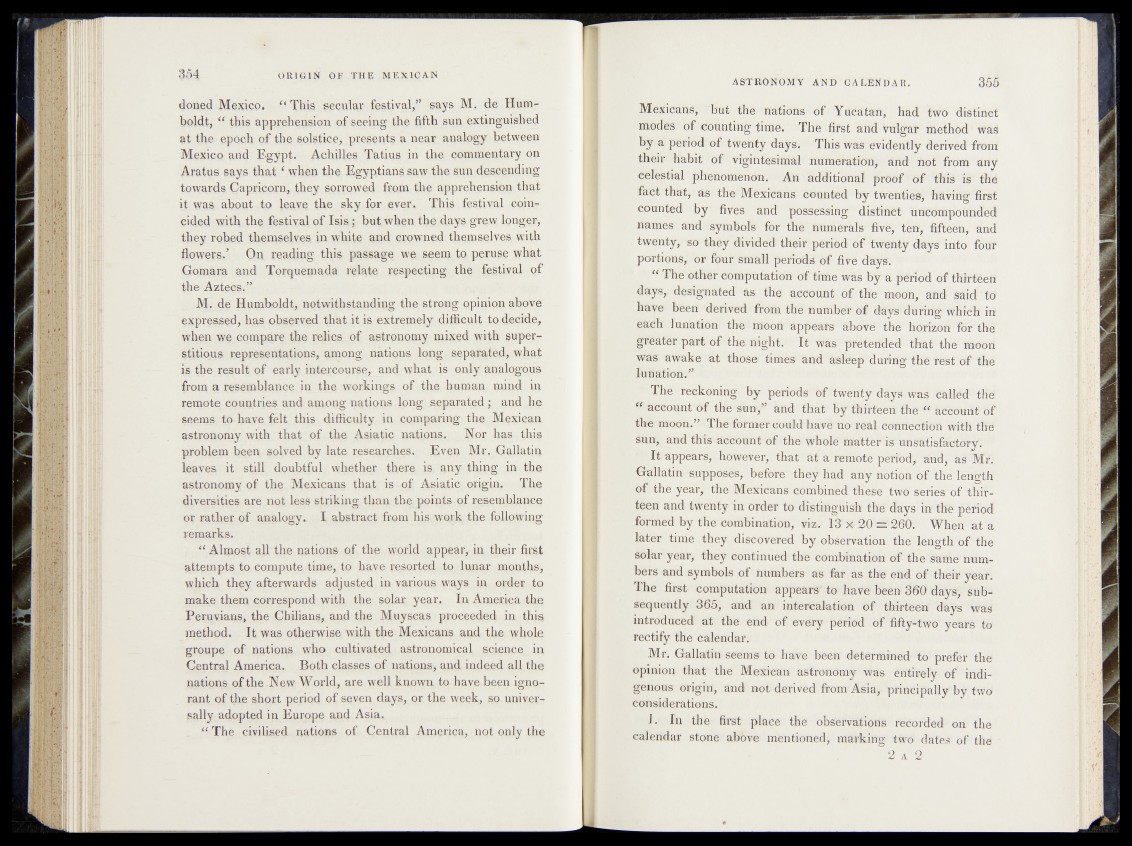
dotted Mexico« ^ Tetris; secular festival/ ;$%ys M, de Hum-
bold,!, “ this apprehension of seeing the fifth, sun extinguished
at tfie epoch of the solstice, presents a near analogy between
Mexico and Egypt* Achilles Tabus in the commentary op
Aretes says that ƒ when the Egyptians saw the sun descending
towards Qaprfeorn* tbej sorrowed from the apprehension that
it was about to feaye the shy for ever, This festival coincided
with the festival of Isia; but when the days grew longer,
they robed themselves, in white and crowned themsel ves.-wi th
flowers,’ On reading this passage we seem to peruse what
Gomara and Torquemada relate respecting the festival of
the Aztecs.”
M. de Humboldt, notwithstanding the strong opinion above
expressed, has observed that it is extremely difficult to decide,
when we compare the relios of astronomy mixed with super?
Stitious representations, among nations long separated, what
is the result of early intercourse, and what is only analogous
from a resemblance in the workings of the humutt mind in
remote countries and among nations long separatedUttd he
seems to have felt this difficulty in, comparing the Me^ic-au
ttstrononiy with that of the Asiatic nations. h |^ this
problem been solved by late researches, ^vep. Mr, QaJfatitt
leaven it still doubtful whether there is raw tfetig in the
astronomy of the Mexicans that is of Asiatic origin. The
diversities are not less striking than, thejpoints of resemblance
or rather of analogy. I. abstract from his wG,§k the following
remarks.
“ Almost all the nations of the world appear, in their first
attempts to compute time, to have resorted to lunar months,
which they afterwards adjusted in various ways in order to
make them correspond with the solar year. In. America the
Peruvians, the Chilians, and the Muyscas proceeded in this
method. It was otherwise with the Mexicans and the whole
groupe of nations who cultivated, astronomical science in
Central America. Both classes of nations, and indeed all the
nations of the New World, are well known to have been ignor
rant of the short period of seven days, or the week, so universally
adopted in Europe and Asia.
: “ The civilised nations of Central America, not only the
ASTRONOMY and calendar. 355
Mexicans, but the nations Of Yuéatàn, had two distinct
modes of counting time. Thé fitst and vulgar method was
by a period Of twenty day#* This Was evidently derived from
their habit d f vigïhtesttÜSl numeration;, and ttót from any
celestial ptoeflomettoft,' An additional proof of this is the
fact that, às the Mexicans éöunted by twenties, having first
counted by fives and' possessing distinct UtiCémpottnded
names and symbols for the fiüméfals five, teft, fifteen, and
. twenty, so they divided their period? of twenty days into four
portions, or four small periods of five days,
' ^ The other eompu tatiott of time Wis by à period óf thirféett
days,, designated as the account of the rhêôtt, attd said id
hay© been derived from, the number of diïtiiig Wife®? id
each lunation the mooft appears aboVC the horizon for the
greater part of the night. It was, pretended that the moon
Was awake ât those times and asleep during thèfè^ff ÉF the
lunation;” .
The reckoning'by periods of “twenty days was calléd tlié
“ account «I the sun,” and that by thirteen the “ accoutt# 0'f
thé* moon.” Thé former could havi*hO reâl cOmiéetion with the
Sttny and this"account of the whole matter is unsatisfactory*; *?
‘ \ It appears, however, that at a rëîttpte period,, and, asrMr.
Gallatin supposes, before they had any'ifdtibn of the length
of the year, the Mexicans combined thel^|t!vo series of thipH
teen and twenty in order to distinguish the days^ in thé period
formed by the combination, viz. 13' * 2 0 = 260. When ut a
later time they discovered by observation the lengfBof the
solar year, they continue# the conabination of the SMe niim-
bers an# symbols of numbers m far as the eftd of their ybari
The first- computation ap p e a r te: lave d a ^ Stth4
sequently 365, and an intercalation Of thirteen days waS
introducé# at the end- of every period of fifty^tWO years to
rectify the calendar.
Mr. Gallatin seem® to have beeft' détermine# tovprefér the
©pinion that the Mexican astronomy' Was entirely of indigenous
origin, an# not derived frôiwiléiây principally: bytWo
considerations.
J. In the first place the obligations rôbor#e# ©a the
calendar stone abbve mentioned^ nmi&iftff two dates* of the ■
2 a 2